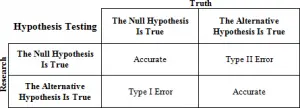Read About Type I Error Type Ii Error In Detail.

Hi everyone,
I wish to ask about type i error type ii error in brief. If anybody is having any clue regarding this, then please explain it in reply.
Thank you in advance.


Hi everyone,
I wish to ask about type i error type ii error in brief. If anybody is having any clue regarding this, then please explain it in reply.
Thank you in advance.


In the testing of statistical hypothesis, a type I error is equivalent to the false rejection of a true null hypothesis, while a type II error is falsely retaining an incorrect null hypothesis. Simply, a type I fault is the detection of an item which is not present, whereas a type II error is the inability to detect a result which is present.
An example of the type I error includes a test which declares a patient is having a disease when in fact, he does not have the disease.
An example of type II error includes a blood test which fails to detect the disease that it was designed to detect.



In hypothesis testing, “type I” error is known also as “false positive.” It is the error of rejecting a null or untrue hypothesis when it is actually true. It is the error of accepting an alternative hypothesis when the results can be attributed to chance. Other term used for type I error is “an error of the first kind.”
For example, in a courtroom, type I error corresponds or is equivalent to convicting an innocent defendant. “Type II” error is known also as “false negative.” It is the error of not rejecting a null hypothesis when the alternative hypothesis is the true state of nature. It is the error of failing to accept an alternative hypothesis when you don’t have adequate or enough power.
This happens when we fail to observe or distinguish a difference when in reality there is one. Other term used for type II error is “an error of the second kind.” In a courtroom example, this is equivalent to acquitting a criminal. Hypothesis testing is the art of testing if difference between two sample distributions can simply be explained or clarified via random chance or not.
